Contact: [email protected]
Video Sources 0 Views
- Watch trailer
- Experiment in Terror Colorized


Synopsis
[ez-toc]




Introduction
Stepping back into the cinematic past, “Experiment in Terror Colorized 1962” invites audiences to rediscover the gripping world of noir suspense. This article embarks on a journey through the creation of the 1962 thriller, unraveling the intricacies of its original form and exploring the transformative effects of colorization. Join us as we delve into the actors, the narrative, critical reviews, and the broader implications of infusing color into this timeless cinematic gem.
Read Media File Transfer Agreement: Terms and Conditions
Read FAQ
The Making of “Experiment in Terror Colorized”
Taut Suspense and Noir Atmosphere
“Experiment in Terror Colorized,” directed by the versatile Blake Edwards, stands as a testament to the artistry of suspenseful storytelling. Released in 1962, this noir masterpiece stars Lee Remick as Kelly Sherwood, a bank teller thrust into a perilous situation orchestrated by a mysterious criminal portrayed by Ross Martin. The film weaves a tapestry of shadows, fear, and uncertainty, characteristic of the noir genre.
Blake Edwards, renowned for his comedic works, showcases his versatility in helming this suspenseful noir thriller. The success of the film hinges on a tight narrative and the dynamic performances of Lee Remick and Ross Martin, who skillfully navigate the intricate web of fear and intrigue. As we explore the making of “Experiment in Terror Colorized,” the foundation of its noir atmosphere comes to life, setting the stage for its colorful transformation.
Exploring the Colorization Process
The decision to colorize a classic like “Experiment in Terror Colorized” brings forth a unique set of challenges and opportunities. Colorization specialists, armed with historical context and a deep understanding of the film’s era, embark on a journey to authentically recreate the palette of the early 1960s. This meticulous process involves studying fashion, architecture, and cultural nuances to ensure a faithful representation of the time.
Colorizing a film shot in black and white demands a delicate balance between artistic interpretation and technological precision. The original lighting, designed for monochromatic cinematography, poses challenges in replicating the intended mood and atmosphere. However, advancements in technology, coupled with the expertise of colorization specialists, allow for a nuanced and vibrant reimagination of the classic.
The controversy surrounding color restoration often centers on concerns about altering the filmmaker’s original intent. “Experiment in Terror Colorized 1962” provides a compelling case study, igniting discussions about the impact of colorization on the authenticity and visual appeal of a beloved classic.
The Significance of Visuals in Noir Suspense
Film noir thrives on visual elements to evoke suspense, tension, and a sense of foreboding. “Experiment in Terror Colorized,” in its original black-and-white presentation, expertly employs shadows and contrasts to heighten the psychological impact of the narrative. The colorization process introduces a new layer of complexity, offering audiences a chance to experience noir in a vibrant and engaging manner.
The allure of film noir lies in its ability to create an immersive experience through visuals. The play of light and shadow, the chiaroscuro lighting, and the atmospheric settings contribute to the genre’s enduring appeal. Colorization, when executed thoughtfully, enhances these elements, breathing new life into the world of “Experiment in Terror Colorized” and providing viewers with a fresh perspective on its noir aesthetics.
Re-Evaluation of a Cinematic Classic
The critical reception of “Experiment in Terror Colorized” has evolved over the years, reflecting shifting perspectives on cinema and storytelling. Initially praised for its suspenseful narrative and strong performances, the film has maintained its status as a classic. As we revisit “Experiment in Terror” in its colorized form, there is an opportunity to reassess its impact and appreciate the nuances of the story through a different lens.
The colorized version introduces a vibrant palette to key scenes, offering a fresh and dynamic viewing experience. The performances of Lee Remick and Ross Martin, now infused with color, take on a new dimension, adding layers to the characters and their interactions. This re-evaluation prompts audiences to explore the film with a renewed sense of curiosity and engagement.
Case Study: Colorized Scenes in “Experiment in Terror Colorized”
Examining specific scenes from the colorized version provides insights into the effectiveness of the restoration process. The colorization of tense moments amplifies the emotional impact, with vibrant hues intensifying the psychological depth of the characters. For example, the use of color in scenes of suspense and confrontation adds a layer of visual intensity, enhancing the overall viewing experience.
However, the subjective nature of colorization is evident as not every scene benefits equally from the addition of color. Some argue that certain moments lose their original impact when stripped of their monochromatic charm, emphasizing the ongoing debate between preserving the authenticity of the past and embracing innovative reinterpretations.
Preserving Film History: The Role of Restoration Efforts
The preservation of film history is a responsibility that extends beyond mere nostalgia. “Experiment in Terror Colorized 1962” exemplifies the commitment to safeguarding cinematic treasures for future generations. Restoration efforts, whether through colorization, digitization, or other techniques, play a crucial role in ensuring that classic films remain accessible and relevant in a rapidly evolving landscape.
As time takes its toll on old films, the risk of losing these cultural artifacts increases. Restoration endeavors breathe new life into cinematic gems, allowing them to be experienced in formats that resonate with contemporary audiences. “Experiment in Terror Colorized 1962” stands as a testament to the importance of these efforts, bridging the gap between the past and the present.
The Debate Over Authenticity: Original vs. Colorized Versions
The debate over the authenticity of colorized films continues to spark discussions within the cinephile community. Purists argue that altering the original format compromises the integrity of the work, while proponents view colorization as a means to enhance accessibility and engage new audiences. “Experiment in Terror Colorized 1962” adds a compelling voice to this ongoing discourse.
Approaching this debate requires an appreciation for diverse perspectives. While some cherish the untouched beauty of black-and-white classics, others find value in experiencing these films in a visually updated format. The colorized version of “Experiment in Terror” encourages viewers to participate in this conversation, prompting reflection on how we perceive and preserve cinematic history.
Conclusion
As we navigate the complexities of restoration, colorization, and the preservation of film history, “Experiment in Terror Colorized 1962” emerges as a captivating chapter in this ongoing narrative. The enduring appeal of classic films lies in their ability to transcend time and captivate audiences across generations. Whether viewed in its original black-and-white splendor or through the prism of colorization, the film remains a testament to the artistry of filmmakers who crafted stories that resonate through the ages.
In celebrating the legacy of old movies and old films, let us embrace both the authenticity of the past and the innovation of the present. “Experiment in Terror Colorized 1962” invites audiences to appreciate the film in its various forms, acknowledging the value of preserving cinematic history while exploring new avenues for engagement. As we continue to cherish the magic of cinema, may we honor the past and present as integral chapters in the rich tapestry of our shared cinematic heritage.
















